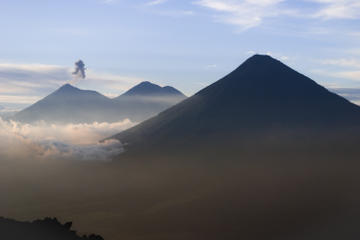
Acatenango
Guatemala’s Pacaya is one of the most popular volcanoes to visit, but travelers shouldn't skip its neighbor, Acatenango. Towering nearly 13,123 feet (4,000 meters), it is Guatemala’s third-tallest volcano and one of the tallest stratovolcanoes in Central America.
Acatenango’s first eruption was in 1924 —relatively recent in comparison to many other volcanoes—though some evidence of its volcanic activity dates back to prehistoric times. Other eruptions occurred shortly after, but it then remained quiet until an eruption in 1972. Since then, Acatenango has been declared dormant.
Acatenango is part of the Fuego-Acatenango massif, or string of volcanic vents, which includes Yepocapa, Pico Mayor de Acatenango, Meseta and Fuego. Acatenango has two main summits: Yepocapa, the northern summit at 12,565 feet (3,830 meters) and Pico Mayor, the southern and highest cone at 13,054 feet (3,976 meters). These are known as Tres Hermanas, and when joined with Fuego, the complex is collectively known as La Horqueta.
Both Acatenango and its twin, Fuego, offer stunning views overlooking the city of Antigua. Ascending Acatenango takes visitors through four different temperate zones — high farmland, cloud forest, high-alpine forest and volcanic. Acatenango is the perfect spot to watch Fuego’s regular activity, which includes audible moans and groans, plumes of smoke and large lava rocks hurling into the air.
Practical Info
Most tours to Acatenango depart from Antigua versus Guatemala City. The best time to attempt a climb is during dry season, which is late November to early April. Hiking Acatenango is strenuous, and you should be in good enough shape to hike several miles a day. While Acatenango could produce debris avalanches, local authorities are well equipped to handle any volcanic activity that transpires, and if there is a risk of eruptions, visitors will not be allowed in the area.
